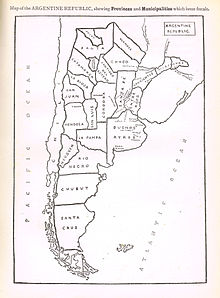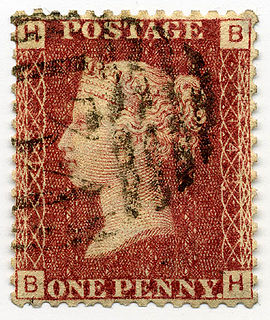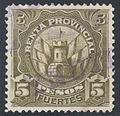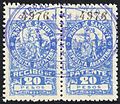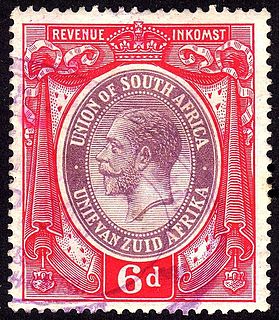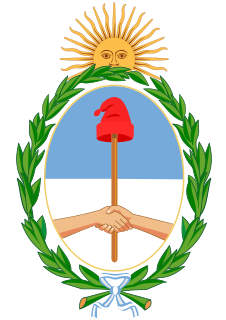
This article is about voting, elections, and election results in Argentina. For details of Argentine government institutions and political parties, see Politics of Argentina.

Departments form the second level of administrative division, and are subdivided in municipalities. They are extended in all of Argentina except for the Province of Buenos Aires and the Autonomous City of Buenos Aires, the national capital, each of which has different administrative arrangements.

The United Provinces of the Río de la Plata, earlier known as the United Provinces of South America, a union of provinces in the Río de la Plata region of South America, emerged from the May Revolution in 1810 and the Argentine War of Independence of 1810–1818. It comprised most of the former Viceroyalty of the Río de la Plata dependencies and had Buenos Aires as its capital.

What today is commonly referred as the Independence of Argentina was declared on July 9, 1816 by the Congress of Tucumán. In reality, the congressmen who were assembled in Tucumán declared the independence of the United Provinces of South America, which is still today one of the legal names of the Argentine Republic. The Federal League Provinces, at war with the United Provinces, were not allowed into the Congress. At the same time, several provinces from the Upper Peru that would later become part of present-day Bolivia, were represented at the Congress.

The Federal Pact was a treaty first signed by the Argentine provinces of Buenos Aires, Entre Ríos and Santa Fe on 4 January 1831, for which a Federal military alliance was created to confront the Unitarian League. Other provinces would later join the treaty.

The San Nicolás Agreement was a pact signed on May 31, 1852 and subscribed by all but one of the 14 provinces of the United Provinces of the River Plate. The treaty consisted of 19 articles, and its goal was to set the bases for the national organization of the young Argentine state. It also served as precedent to the sanction of the Argentine Constitution of 1853.
The Battle of Cepeda of 1820 took place on February 1 in Cañada de Cepeda, Santa Fe, Argentina.

The Treaty of Pilar was a pact signed among the rulers of the Argentine provinces of Santa Fe, Entre Ríos and Buenos Aires, which is recognized as the foundation of the federal organization of the country. It was signed in the city of Pilar, Buenos Aires on 23 February 1820 by governor Estanislao López for Santa Fe, caudillo Francisco Ramírez for Entre Ríos, and provisional governor Manuel de Sarratea for Buenos Aires, after the dissolution of the national government caused by the Battle of Cepeda. A reference to it was included in the Preamble of the Argentine Constitution of 1853 as one of the "pre-existing pacts" fulfilled by it.

The National University of the Littoral is a university in Argentina. It is based in Santa Fe, the capital of the province of the same name, and it has colleges and other academic facilities in Esperanza, Reconquista and Gálvez, also in Santa Fe Province.

The Battle of Pavón was a key battle of the Argentine civil wars. It was fought in Pavón, Santa Fé Province, Argentina on 17 September 1861, between the Army of the State of Buenos Aires, commanded by Bartolomé Mitre, and the Army of Republic of the Argentine Confederation commanded by Justo José de Urquiza. The withdrawal of Urquiza left the field to Mitre.

Argentine postage stamps were first issued in 1858 by the Argentine Confederation and nationally by the new Republic's National Postal Service in 1862. Due to the continuing civil wars, a number of provinces and territories, particularly in the then-remote far north and far south, continued to issue their own postage brands and stamps for some time, afterwards; some of these issues have since become collectors' items.

The Federal League or League of Free Peoples was an alliance of provinces in what is now Uruguay, Argentina and Brazil that aimed to establish a confederal organization for the state that was emerging from the May Revolution in the war of independence against the Spanish Empire.
Geoffrey Clive Akerman was an English philatelist. In 2001, Akerman and Gavin H. Fryer won the Crawford Medal from The Royal Philatelic Society London for their work "The Reform of the Post Office in the Victorian Era and Its Impact on Economic and Social Activity". He won numerous other awards for displays at stamp exhibitions. In 2009, Akerman won the Revenue Society Research Medal.
Swiss Argentines are Argentine citizens of Swiss ancestry or people who emigrated from Switzerland and reside in Argentina. The Swiss Argentine community is the largest group of the Swiss diaspora in Latin America.

The Argentine Civil Wars were a series of civil wars that took place in Argentina from 1814 to 1880. These conflicts were separate from the Argentine War of Independence (1810–1820), though they first arose during this period.
The Battle of Caaguazú took place in Mercedes Department, in Corrientes Province, Argentina on 28 November 1841, during the Argentine Civil War, between the forces of Entre Ríos Province, commanded by brigadier Pascual Echagüe and Corrientes Province, under brigadier José María Paz, with a sound defeat of the Federal Party forces of Entre Ríos.

Pascual Echagüe, was an Argentine soldier and politician. He served as Governor of Entre Ríos and Santa Fe provinces and Minister of War and Navy during the governments of Urquiza and Derqui. He participated in the Argentine Civil Wars and the Uruguayan Civil War.

The State of Buenos Aires was a secessionist republic resulting from the overthrow of the Argentine Confederation government in the Province of Buenos Aires on September 11, 1852. The State of Buenos Aires was never recognized by the Confederation or by foreign nations; it remained, however, nominally independent under its own government and constitution. Buenos Aires rejoined the Argentine Confederation after the former's victory at the Battle of Pavón in 1861.
The Quadrilateral Treaty was a pact between the Argentine provinces of Buenos Aires, Santa Fe, Entre Ríos and Corrientes, signed on 25 January 1822. The treaty was intended to be an offensive-defensive pact between the signatories, in front of an attack by Luso-Brazilian invasion from the Banda Oriental, which was seen as very probable. It also wanted to establish peace after the defeat of the caudillo from Entre Ríos, Francisco Ramírez, who in 1821 had invaded Santa Fe and Córdoba Provinces, without success.
